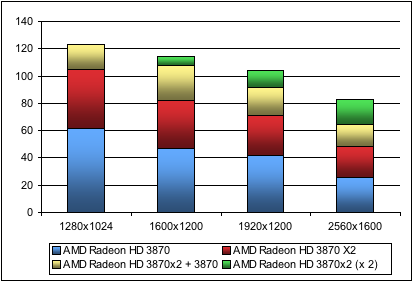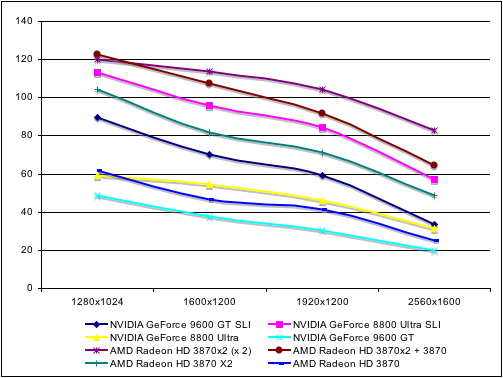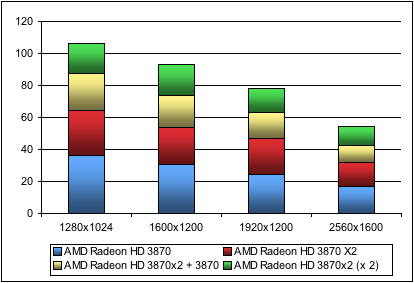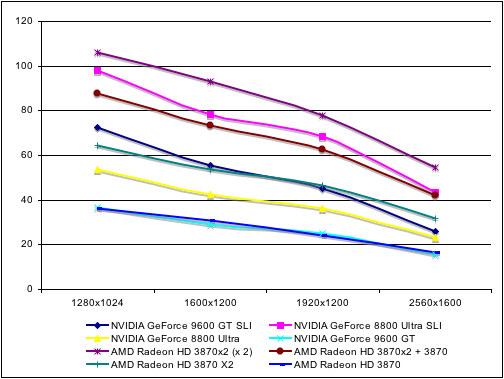CrossFireX Arrives: First Look at 3 and 4 GPUs in 2 Card Setups
by Derek Wilson on March 7, 2008 12:05 PM EST- Posted in
- GPUs
The Elder Scrolls IV: Oblivion Performance
Version: 1.2.0416 Shivering Isles
Settings: Ultra High Quality settings defaults with Vsync disabled.
Our Oblivion test takes place in the south of the Shivering Isles, running through woods over rolling hills toward a lake. This is a straight-line run that lasts around 20 seconds and uses FRAPS to record framerate. This benchmark is very repeatable, but the first run is the most consistent between cards, so we only run the benchmark once and take that number.

Our tests show that moving beyond two GPUs in a DX9 game that already benefits well from multi-GPU has the potential to make use of three or four GPUs. As resolution goes up, the usefulness of more than two GPUs goes up. Clearly, there is potential for scaling with games that don't make extensive use of features that get in the way of multi-GPU performance. It should also go without saying that this is a technology that should be reserved for the ultra high-end setups. Hopefully illustrating that with resolution scaling will help bring the point home.

| Oblivion Perfomance | ||||
| 1280x1024 | 1600x1200 | 1920x1200 | 2560x1600 | |
| NVIDIA GeForce 9600 GT SLI | 89.8 | 70.4 | 59 | 33.7 |
| NVIDIA GeForce 8800 Ultra SLI | 113.1 | 96.1 | 84.2 | 57.4 |
| NVIDIA GeForce 8800 Ultra | 59.5 | 54.4 | 46 | 31.5 |
| NVIDIA GeForce 9600 GT | 49 | 37.5 | 30.6 | 19.8 |
| AMD Radeon HD 3870X2 (x 2) | 120.3 | 114 | 104.1 | 82.8 |
| AMD Radeon HD 3870X2 + 3870 | 122.9 | 107.6 | 91.5 | 64.5 |
| AMD Radeon HD 3870X2 | 104.5 | 82 | 71.1 | 48.6 |
| AMD Radeon HD 3870 | 61.8 | 46.8 | 41.5 | 25.4 |
AMD tends to lead in this benchmark normally, and the 8800 Ultra barely leads the Radeon HD 3870, which is normally in competition with the GeForce 9600 GT. In this case, the 8800 Ultra SLI loses to the three GPU AMD setup (3870X2 + 3870), while four GPUs show an even more significant advantage at higher resolutions. 9600 GT SLI, which would normally compete with the 3870X2, doesn't really come through in Oblivion.

Enabling AA and AF reveals one of the major strengths of multi-GPU acceleration: antialiasing comes at less cost. In this case, even at lower resolutions, all four GPUs are able to contribute and performance stays high. While CrossFire and SLI both enable huge levels of AA, at high resolutions a little bit goes a long way.

| Oblivion 4xAA/16xAF Performance | ||||
| 1024x768 | 1280x1024 | 1600x1200 | 1920x1200 | |
| NVIDIA GeForce 9600 GT SLI | 72.7 | 55.4 | 45.3 | 26.1 |
| NVIDIA GeForce 8800 Ultra SLI | 98.1 | 78.5 | 68.3 | 43.3 |
| NVIDIA GeForce 8800 Ultra | 53.8 | 42.4 | 36.1 | 23.1 |
| NVIDIA GeForce 9600 GT | 36.9 | 29.2 | 25 | 15.6 |
| AMD Radeon HD 3870X2 (x 2) | 106.1 | 93.3 | 78.1 | 54.5 |
| AMD Radeon HD 3870X2 + 3870 | 87.6 | 73.6 | 62.9 | 42.3 |
| AMD Radeon HD 3870X2 | 64.4 | 53.6 | 46.6 | 31.7 |
| AMD Radeon HD 3870 | 36.4 | 30.9 | 24.4 | 16.7 |
While two 3870X2 cards do lead overall, 8800 Ultra SLI does best the three GPU combination of the 3870X2 and the 3870. Oblivion certainly shows that more than two GPUs can contribute to performance, and that AMD was right when they said DX9 games running under Vista would show the most potential for improvement with four GPU systems.










36 Comments
View All Comments
mmntech - Saturday, March 8, 2008 - link
I'm running an HD 3850 256mb and I get 40fps average in low density areas, 12.4fps in London. Ultra quality of course with no AA and in game AF at 1440x900. That's DirectX 9.0 performance, which is all I could test since I don't run Vista. Flight Simulator has always been very CPU dependent, particularly concerning autogen scenery, and AI traffic along with the complex physics engine. Since FSX with SP1 can take advantage of up to four CPU cores, it might be worth starting off there. I did my tests using an Athlon 64 X2 3800+, everything at stock speeds with 2gb PC3200. If I were you, I'd go with the single 3870 X2 card. Cheaper than buying two separate 3870s. For nVidia, maybe two 8800GTS 640mb cards in SLI or better if you want the best performance. I'd wait for nVidia to release the 9800GX2 first though to see what cards offer the best performance per dollar.As for the article, I really wonder if using more than two cards is really practical. You can get almost the same performance with two 9600GTs as with three or four HD 3750s but the two 9600GTs are far cheaper. This begs the question, is spending the extra $400 really worth it for such minimal gains? I know for some it is but then why buy mid-range cards when a couple 8800GTXs will cost the same in the end. Plus there's also the increased heat and power consumption from using four cards instead of two. I'd like to see more info on that.
Incisal flyer - Monday, March 10, 2008 - link
Thanks for the replies derek anm mmntech. Mmntech, yes my feelings exactly about quad (basically) crossfire. I'm no computer geek (more like a newbie really - I don't understand understand most of what I read in the forums and couldn't overclock a toaster if you held my mother hostage). Multiple crossfire sounds just too exotic at this point and would be more headache than it is worth. Thanks for your feedback and happy flying.The Flyer
DerekWilson - Saturday, March 8, 2008 - link
i'm looking at fsx acceleration for future graphics articles ...no promises, but i've been testing it internally.
Sundox - Saturday, March 8, 2008 - link
isn't multi GPU the cheap way to go?I'm asking this because I can't figure a car race won by two slower cars, against the faster car, or two knifes cutting my steak smoother.
to me, it looks like the problem is,... coping with the problem, the companies just want to have the most powerful GPU, not the most efficiant.
I might be totaly wrong.
coldpower27 - Saturday, March 8, 2008 - link
It's more like a delivery race rather then a car race, who can deliver the total shipment fastest?Two smaller trucks pulling half the load each, or a single truck pulling a larger load, the larger truck's engine is more complex, and hence more difficult to build, vs the smaller trucks which have smaller engines which are easier.
Griswold - Saturday, March 8, 2008 - link
Analogies like that do not always work just like that.Besides that, the car race example isnt that simple anyhow. Imagine a 24h race which could easily be won by even one slower car, as long as it is more reliable than the faster one. Remember, in order to finish first, one must first finish. This, of course, has little to nothing to do with video cards, hence, analogies dont always work.
legoman666 - Saturday, March 8, 2008 - link
analogies almost never work.DerekWilson - Saturday, March 8, 2008 - link
"Like a balloon, and... something bad happens!"Simon128D - Saturday, March 8, 2008 - link
I love the reviews and benchmarks here, I really do but I'm getting sick and tired of seeing the test system being only a super high end machine with hardware that the average person can't afford and I think benchmarking with skull trail on its own is silly. Tis applies to other site as well.Don't get me wrong, I enjoy seeing benchmarks from a high end system like skull trail but how many people actually have or can afford a system like that. I'd like to see more of a mid range setup inculded in graphics benchmarks - that will give a more realistic view point. A system say with a 780i or X38 chipset with a Q6600 and 4GB DDR2 800Mhz etc.
Just my thoughts.
DigitalFreak - Saturday, March 8, 2008 - link
It's really the only way to make sure the games they're testing with aren't CPU limited.